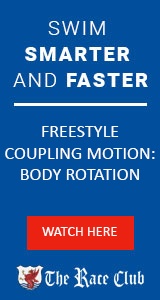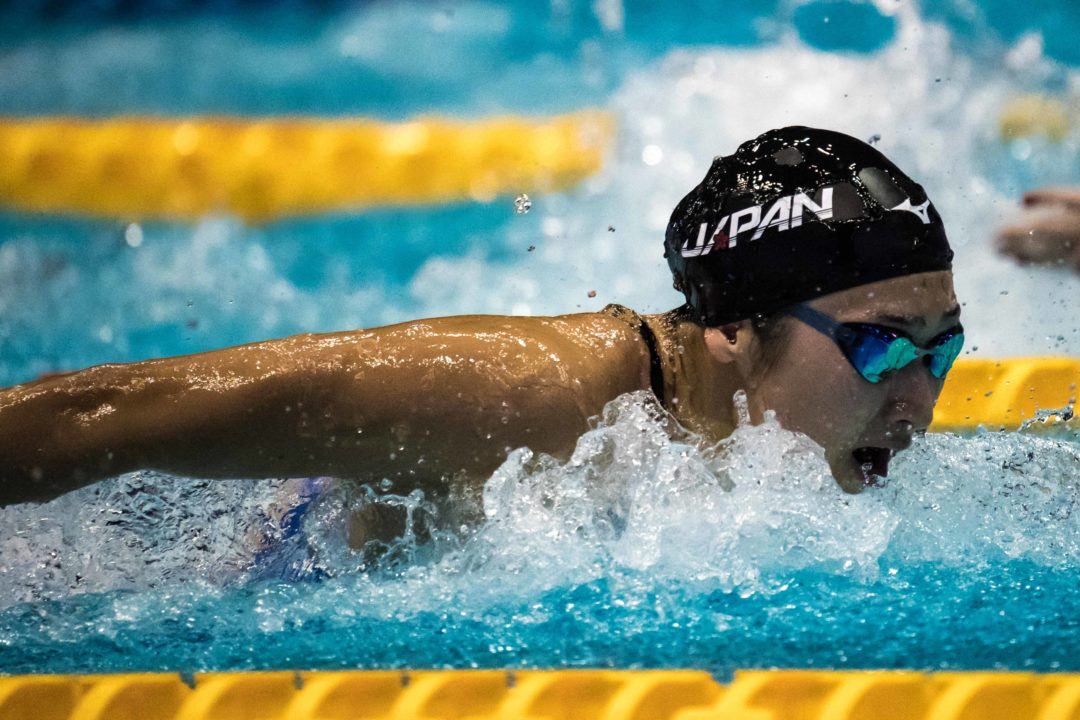Courtesy of Gary Hall Sr., 10-time World Record Holder, 3-time Olympian, 1976 Olympic Games US Flagbearer and The Race Club co-founder.
Rikako Ikee has already proven to be one of the fastest women butterfly swimming competitors in the world. She should certainly be contending for the gold medal in the women’s 100 meter butterfly at both the world championships in 2019 and the Olympic Games of Tokyo in 2020.
Watching Rikako swimming butterfly, you will see that she has very high recovering arms on both sides; a very vertical arm recovery compared to most. Her hands are well above her elbows on her recovery. Laszlo Cseh of Hungary has a similar recovery among the men’s butterfly swimming.
 The advantage of a more vertical recovery in swimming butterfly is that the gravitational force assists in the arms coming down to the water more forcefully when compared to a more common horizontal recovery. The higher kinetic energy of the arms at entry couples with the second down kick and enables the swimmer to surge forward faster after this second butterfly kick.
The advantage of a more vertical recovery in swimming butterfly is that the gravitational force assists in the arms coming down to the water more forcefully when compared to a more common horizontal recovery. The higher kinetic energy of the arms at entry couples with the second down kick and enables the swimmer to surge forward faster after this second butterfly kick.
In order to do this vertical recovery in swimming butterfly, the swimmer needs to have extraordinarily high extension flexibility of the shoulders. At The Race Club, we grade all of our swimmers for flexibility in all of the important joints used in swimming. In the butterfly swimming stroke and the freestyle swimming stroke, the ability of the swimmer to extend the shoulders backwards is a key advantage. With both of these swimming strokes extension of the shoulders helps in the recovery motion and in the high elbow pulling motion.
With the arms held at shoulder level height, back straight and palms facing downward, we extend the arms backwards holding the arms near the elbows until the force produces some discomfort to the swimmer. If the elbows are a few inches apart when that occurs, we would score that as a 6. With one inch of separation, it is a 7. Barely touching the elbows together would be considered an 8. Overlapping elbows is a 9 and when the elbows can move past each other, that is a 10.
Every swimmer that I have seen that can use Rikako’s butterfly technique has an 8, 9 or 10 score on shoulder extension. Even those swimmers that have the extra shoulder flexibility may still be challenged with this high arm recovery technique, as it requires more attention and work to accomplish than a lower arm recovery.
I do believe that coupling with the arms and head (and to lesser extent the shoulders) can be a powerful technique in butterfly. The extra effort of Rikako’s high arm recovery, for those able to do so, may be well worth the effort.
This week in Lanes 2, 3 and 4 you will find a valuable webisode on another important coupling motion for freestyle swimming, body rotation. For those in Lanes 3 and 4, you will find some very good data on distance ace Zane Grothe on why the body rotation is so important in freestyle swimming. We hope you will enjoy them. In Lanes 3 and 4, American record holder Zane Grothe will show you why you need to keep your toes pointed coming off the walls on your turns.
Yours in butterfly swimming,
Gary Sr.

Gary Hall, Sr., Technical Director and Head Coach of The Race Club (courtesy of TRC)
Like The Race Club on Facebook
Follow The Race Club on Instagram
Follow The Race Club on Twitter
Connect to The Race Club / Gary Hall Sr. on Linkedin
THE RACE CLUB
Because Life is Worth Swimming, our mission is to promote swimming through sport, lifelong enjoyment, and good health benefits. Our objective is for each member of and each participant in The Race Club to improve his or her swimming performances, health, and self-esteem through our educational programs, services and creativity. We strive to help each member of The Race Club overcome challenges and reach his or her individual life goals.
The Race Club provides facilities, coaching, training, technical instruction, video, fitness and health programs for swimmers of all ages and abilities. Race Club swim camps are designed and tailored to satisfy each swimmer’s needs, whether one is trying to reach the Olympic Games or simply improve one’s fitness. Our programs are suitable for beginner swimmers, pleasure swimmers, fitness swimmers, USA swimming or YMCA swimmers, or triathletes; anyone who wants to improve swimming skills. All of our Race Club members share an enjoyment of being in the water and use swimming to stimulate a more active mind and body.


Just don’t let it get too wild like this
https://youtu.be/9H6zpBGVQL8
Interesting. At around the 50 second mark, she eases off with the arm and torso snap, but finishes with two more “snapstrokes” at the very end. Maybe, she was trying to turn over faster by shortening her stroke in order to separate herself from the field?
All science aside, at the of the day anatomy determines technique. What is faster for one athlete does not “fly” for another. If this was the case, all would be swimming fly like Phelps, or underwater like Coughlin. They tried it. Their coaches tried it. Didn’t work for them. She is doing what works for her. And now we have an interesting new stroke for others to try! I hope she is doing something for the hypermobility in shoulders, however…
Not Lazlo, but Laszlo.
Flexible shoulders.
Well, they once said that the future of butterfly was breathing to the side but who would be crazy enough to breath such a pell-mell way now???
That aside, here’s a swim swam link of Ikee from April with good side and behind views from above and an excellent below view from the side:
https://swimswam.com/watch-rikako-ikees-56-38-100-butterfly-from-tokyo/
I think her arms recovery is driven by the explosive force of her upper body snapping – to use Gary Sr.’s term – down into the water.. On her non-breathing cycles, her arms don’t appear to be as extreme as on her breathing cycles.
The underwater view clearly shows that whatever she is doing above the water is setting up a textbook propulsive phase.
Shoulder impingement to the max. Surprised Cseh has lasted so long, though he was primarily an IMer for the first 100 years of his career. Maybe the alternate strokes helped with compensations and reducing the risk. It may be faster, but shoulder health would be a long-term issue.
Love these points from Gary Hall. He always brings up interesting topics. That being said, he states:
“The advantage of a more vertical recovery in swimming butterfly is that the gravitational force assists in the arms coming down to the water more forcefully… The higher kinetic energy of the arms at entry couples with the second down kick and enables the swimmer to surge forward faster after this second butterfly kick.”
It has always been my understanding that keeping your arms lower and a “softer” entry at the top of the stroke in butterfly is more effective to promote recovery between strokes, and keeping the hands from diving underneath the body once you enter the water. Phelps is obviously the… Read more »
Look at Sjostrom’s style who is defiantly faster in butterfly than Ikee. It is almost no difference between her fly and freestyle strokes in term of arm movement.
Actually she is faster in everything, so maybe not a good example for comparison.
Also after watching one more time Ikee’s races I didn’t get an impression that she was trying to achieve max possible vertical speed of her arms at the point of touching the surface of the water. And even if she does that it isn’t clear what this speed has to do with the improving of propelling force. If vice versa making high arch is the way to relax muscles before engaging them into next cycle of… Read more »
Hey, you’re writing about a girl who’s actually “swimming” for her life. Don’t forget it.
I think the second (flexible).
There are two issues here, energy expended on the recovery and the kinetic energy of the arm swing at the moment of the second down kick. Lower arm recovery with softer entry requires less energy (work) to accomplish, but results in less KE coupling with the down kick. The KE of the arm recovery (circular motion) is proportional to the square of the arm length. So with Phelp’s long levers, he is actually producing a lot of KE at hand entry, even though he makes it look as if there is not.
It is remarkable to me that Laszlo Cseh can go 50 point in the 100 fly with virtually no first down kick. He puts so much energy… Read more »
Should probably attach a video of her swimming
There’s plenty on YouTube
She is not going to be at Worlds this year.
That is not 100% yet, but most likely she will not…
No she has confirmed that she will not swim the qualification meet.